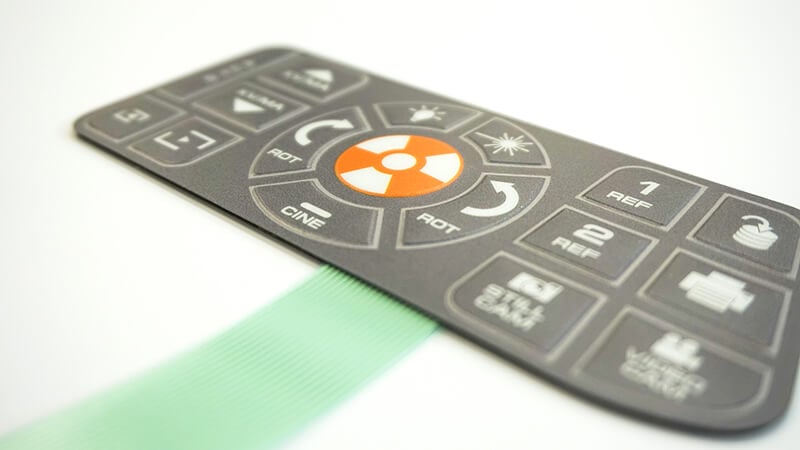Just How to Make Sure Longevity and Dependability with a High-Quality Membrane Switch
Just How to Make Sure Longevity and Dependability with a High-Quality Membrane Switch
Blog Article
How Membrane Layer Switches Contribute to the Toughness of Electronic Control Panels
Membrane layer buttons play an important function in boosting the sturdiness of electronic control panels, mostly through their multi-layered building and construction which supplies reliable defense against ecological factors such as moisture and dust. The lack of relocating components substantially reduces the chance of mechanical failings, making membrane switches ideal for demanding applications.
Meaning of Membrane Layer Switches

Membrane buttons are created to be slim and light-weight, making them suitable for applications where room is restricted. They can be made in different shapes, sizes, and colors, providing versatility in layout that satisfies visual and practical needs. Additionally, membrane switches can incorporate numerous innovations, such as tactile comments and LED signs, enhancing customer experience.
Due to their building and construction, membrane buttons are usually resistant to dirt, wetness, and general wear, adding to their durability in requiring atmospheres. Their smooth design not just helps with easy cleansing however likewise minimizes the risk of mechanical failure, making them a favored choice for manufacturers seeking trustworthy individual interfaces in their electronic control board.
Security Versus Environmental Aspects
The layout of membrane layer switches over inherently provides a degree of defense against numerous environmental variables, which is crucial for keeping performance in difficult problems - Membrane Switch. These switches are commonly constructed with layers of versatile materials that secure interior elements from moisture, dirt, and impurities. By encapsulating the circuitry, membrane changes reduce the threat of brief circuits and corrosion, which can significantly harm performance
Moreover, making use of robust adhesives and sealers during production enhances their resistance to environmental challenges. Membrane switches can endure direct exposure to chemicals and solvents, making them ideal for sectors such as food processing and healthcare, where health and tidiness are critical. Their smooth surface style additionally prevents the accumulation of dirt and bacteria, facilitating easier cleaning and upkeep.
Temperature variations are another ecological concern, and membrane buttons are crafted to function effectively across a large range of temperatures (Membrane Switch). This flexibility makes certain that control board continue to be operational in numerous settings, from commercial environments to consumer electronics
Effect on Customer Communication
Individual interaction with digital control board is considerably affected by the layout and capability of membrane buttons. These switches supply a tactile interface that boosts the general individual experience, enabling instinctive navigating and control. Their receptive nature makes sure that users receive immediate feedback upon activation, which is essential for tasks needing precision and efficiency.
In addition, the smooth surface area of Discover More Here membrane layer changes promotes easy cleaning and maintenance, advertising customer self-confidence in the dependability of the user interface. This sanitation is especially crucial in settings where hygiene is vital, such as medical or food processing settings. Additionally, the compact and lightweight design of membrane switches adds to the visual charm of control panels, motivating customer engagement via a modern-day and smooth look.
Furthermore, the integration of aesthetic elements, such as printed symbols More Help and backlighting, helps users quickly recognize features, decreasing the finding out curve related to brand-new devices. Consequently, users can run tools better, bring about boosted efficiency and complete satisfaction. In recap, membrane buttons play a pivotal duty in boosting individual communication by integrating functionality, aesthetics, and convenience of usage, eventually causing enhanced functional effectiveness.
Style Versatility and Personalization
Design flexibility and personalization are necessary facets of membrane buttons, making it possible for producers to customize electronic control panels to specific applications and user needs. This adaptability enables for the assimilation of numerous design components, such as colors, graphics, and textures, which can boost the aesthetic appeal and customer engagement of the control board.
Membrane layer switches can be customized in shapes and size, accommodating a large range of tools and applications, from commercial equipment to consumer electronics. This adaptability makes certain that makers can develop user-friendly user interfaces that line up with user expectations and operational needs. Additionally, the capacity to include one-of-a-kind attributes such as backlighting or responsive responses additionally boosts usability, enabling a much more interactive experience.
Furthermore, the manufacturing process for membrane layer changes supports the quick prototyping of designs, allowing makers to iterate and refine their principles quickly. This ability not only increases the advancement timeline however additionally look at these guys makes certain that the final product meets particular functional and visual requirements.

Cost-Effectiveness and Longevity
Cost-effectiveness and long life are considerable advantages of membrane buttons, making them an attractive choice for producers and end-users alike. These switches are normally cheaper to produce than traditional mechanical buttons, mostly as a result of their simplified production processes and the reduced number of parts required. This expense advantage prolongs not just to initial production however also to long-lasting operational expenses, as membrane layer buttons frequently need less maintenance and have a lower failure price.
In addition, the longevity of membrane layer changes adds to their overall value. Constructed from long lasting materials, they are resistant to ecological factors such as moisture, dirt, and chemicals, which can bring about early wear in various other button kinds. The lack of relocating parts lessens mechanical failing, permitting membrane switches to keep capability over expanded durations.
This resilience is particularly useful in applications needing consistent performance under demanding conditions, such as clinical tools and industrial devices. Eventually, the combination of cost-effectiveness and durability makes membrane layer changes a financially sensible choice for makers, supplying trustworthy solutions that hold up against the test of time while enhancing financial considerations.
Verdict
In final thought, membrane switches substantially boost the toughness of digital control panels through their durable construction and safety attributes - Membrane Switch. Overall, membrane changes represent a trustworthy and cost-effective option for boosting the long life and functionality of electronic control systems.
Report this page